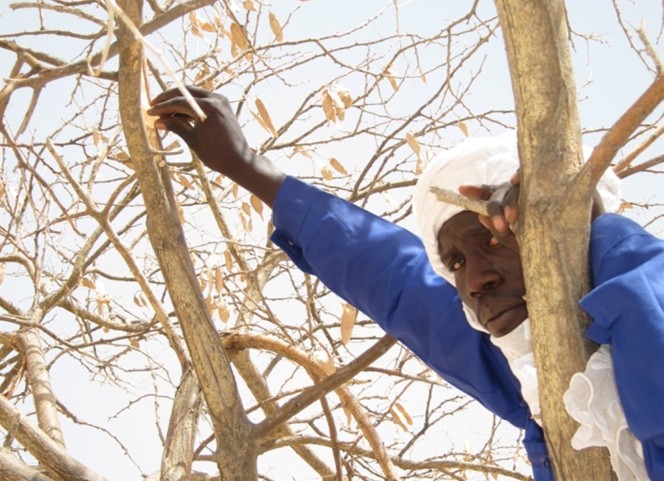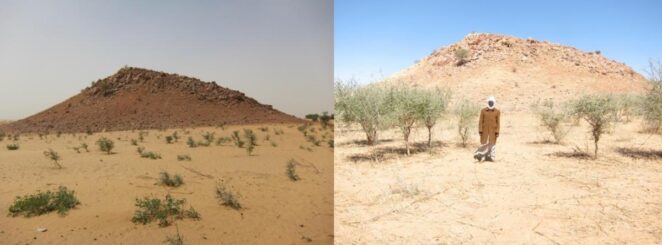Restoration of degraded ecosystems in the Sudanese refugee-hosting area in eastern Chad

Introduction
Over 360,000 Sudanese refugees are hosted in twelve main camps in eastern Chad,since 2004 for many of them. This greatly increased the need for natural resources in the area thereby degrading the fragile semi-arid Sahelian ecosystems.The present initiative aims to promote the peaceful cohabitation between local and displaced communities based on joint rehabilitation of the overexploited ecosystems and sustainable management of natural resources in the refugee-hosting areas. Host and displaced communities are firmly engaged in the protection and management of large Acacia senegal tree stands producing the valuable gum arabic.
This initiative does not only contribute to the livelihoods and resilience of the communities, but also represents an appropriate and low cost climate change adaptation measure. The current article presents the initiative progress based on key findings of a multi-actor field mission carried out from 21 to 29 January 2020 in the refugee-hosting area.
Project summary
The humanitarian–development–peace institutional contextof the project
This initiative launched by humanitarian actors will be taken further by a development project thereby enhancing the restoration of affected ecosystems and facilitating the upscaling of the approach based on the use of natural regeneration.
This humanitarian pilot project was implemented by local NGOs under the lead of UNHCR from 1 May 2017 to 31 December 2018 in three zones in the vicinity of several Sudanese refugee camps, while SDC ensured the technical backstopping and supported the remote sensing for closely monitoring the restoration of the affected ecosystems.
After a self-assessment workshop in 2018 in Iriba, SDC decided to integrate the ecosystem restoration activities of the pilot project into the development project Gestion des Eaux de Ruissellement dans le Tchad Sahélien (GERTS) implemented by GIZ. By combining the efforts of the two projects, the ecosystem can be rehabilitated more comprehensively based on a joint local land use agreement:
- thus the use of water-spreading weirs will raise the level of the ground-water table close to the surface thereby favouring an increase of cultivable acreage and revegetation along wadis (dry valleys);
- while the controlled agro-sylvo-pastoral management upstream of the weirs will favour the natural regeneration of woody plants (and grasses), thereby also reducing the siltation of the weirs and the agricultural land.
Focus of the project
The integrated project approach focusses on:
- the elaboration of local land use agreements (conventions locales) for a joint and controlled agro-sylvo-pastoral management of the restoration zones by all relevant stakeholders (including semi-nomadic herders);
- the techniques of “assisted natural regeneration” combined with soil conservation work to restore the vegetation cover;
- the systematic monitoring of the restoration effect using advanced remote sensing;
- the promotion of additional income-generating activities based on natural resources (e.g. the production of gum arabic) to gain the support of the beneficiaries for environmental conservation.
Outcomes and Impacts
The following achievements of the local host and displaced communities have been noted during the field mission in January 2020, especially on the protected tree sites east of Guéréda.
- Mixed communities continued to protect Acacia senegal, the tree producing the valuable gum, from livestock browsing through awareness raising and regular patrolling by watchmen.
- They also greatly enlarged the restoration area by including additional sites with abundant Acacia senegalnatural regeneration.
- Reduced grazing and browsing (mainly dromedaries and goats) have stimulated the locally abundant natural regeneration of Acacia senegal through vigorous (re)sprouting shoots.
- Within less than two years the natural regeneration of Acacia senegalexceeded the height of a man (see figure) and in two to three years the top of the canopy will be out of reach by dromedaries.
- Overall we estimate that the host and displaced communities of Kédédé/Djondjorong have protected and favoured the natural regeneration of Acacia senegal on a total area of over 1,000 ha. For comparison, the tree planting costs for such an area, taking into account tree maintenance for the first two years, would amount to about US$ 1.5 million (estimated by the Technical Directorate General of Forests).
This initiative practically demonstrates the successful working in the humanitarian – development – peace nexus by continuing a primary humanitarian project through development actors considering joint and peaceful management of natural resources by host and displaced communities.

Next steps
It is suggested now to organise, together with the Ministry of the Environment, Water and Fisheries and UNDP, a national workshop in N’Djamena on the topic “assisted natural regeneration versus traditional tree plantation” which will serve to define a national afforestation strategy considering natural regeneration.
Furthermore, the workshop would facilitate the national scaling up of the approach. There is a high replication potential in the restoration of degraded ecosystems in the context of ongoing natural resources depletion and increasing climate variability worldwide.
This nature-based solution is an instructive case study for the upcoming UN Decade on Ecosystem Restoration (2021-2030).
Related resources
- Read more on the UN Decade on Ecosystem Restoration (2021-2030)
- Find out about forest landscape restoration
- Read about African Forest Landscape Restoration Initiative (AFR 100)
- Read Beyond tree planting on CIFOR Forests News:
- Read the article on Positive site selection bias in meta-analyses comparing natural regeneration to active forest restoration
- Learn about Building resilience through ecosystem restoration in Somali Regional State, Ethiopia
(0) Comments
There is no content